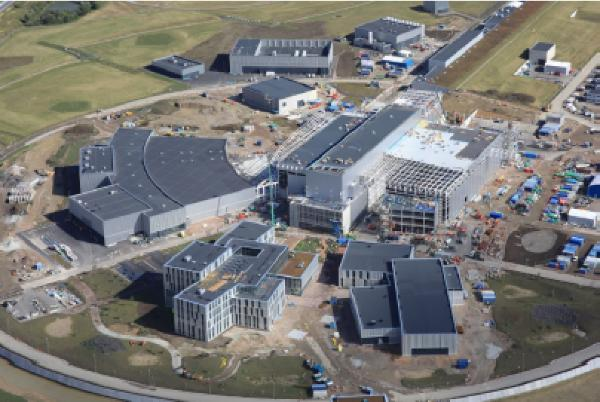
- European Investment Bank signs third credit facility to support European Spallation Source (ESS) research infrastructure in Lund, Sweden.
- The €50 million credit line is supported under InnovFin, funded by the EU’s Horizon 2020 research and innovation programme.
The European Investment Bank (EIB) has signed a €50 million (SEK 505 million) loan agreement with the European Spallation Source (ESS) in Lund, Sweden. The credit facility was extended under the “InnovFin – EU Finance for Innovators” programme, with the financial backing of the European Union under Horizon 2020, the EU’s programme for research and innovation. This loan follows an existing credit facility started in 2016, for a total exposure of €200million. The construction of the ESS is progressing despite the ongoing COVID-19 pandemic, with about three quarters of the project complete at the end of 2020.
The ESS project originally marked the first time a project with an ERIC* statute was directly financed by the EU bank. Apart from providing financing, the EIB’s InnovFin Advisory Service also provided technical advice to pave the way for the successful conclusion of the loan agreement.
“ESS’ unique research capacity creates a wide range of new opportunities in the fields of life sciences, energy and environmental technology, which are also priority objectives for the EIB." said EIB Vice-President Thomas Östros. “We have supported ESS from the beginning and are happy to continue our commitment to this landmark achievement of European scientific effort. Europe needs to stay on the forefront of international scientific research and we are committed to financing research projects where we can.”
Mariya Gabriel, European Commissioner for Innovation, Research, Culture, Education and Youth, said: “The Commission is pleased to extend its support to ESS and its unique research capacity. This highly ambitious project is making a significant step forward in the science of everyday life and we are proud to be part of its success story.”
ESS can be compared to a large microscope, as neutron scattering techniques offer the possibility to study material structures and motions at an atomic or molecular level. ESS will enable scientists to see and understand basic atomic structures and forces at length and time scales unachievable at other spallation sources. It thus opens new opportunities for researchers in multiple disciplines such as life science, environment, energy, transport and engineering, as well as physics, chemistry and even archaeology.
The advancement of the ESS facility in May 2021
Background Information:
The European Investment Bank (EIB) is the long-term lending institution of the European Union owned by its Member States. It makes long-term finance available for sound investment in order to contribute towards EU policy goals. In terms of research projects, the EU bank previously also helped to finance the Large Hadron Collider at CERN.
InnovFin - EU Finance for Innovators - Under Horizon 2020, the EU research and innovation programme for 2014-2020, the European Commission and the European Investment Bank Group (EIB and EIF) launched a new generation of financial instruments and advisory services in 2014 to help innovative firms access finance more easily. InnovFin – EU Finance for Innovators offers a range of tailored products which provides financing in support of research and innovation by small, medium-sized and large companies and the promoters of research infrastructure.
InnovFin Large Projects aims to improve access to risk finance for research and innovation (R&I) projects emanating from larger firms; universities and public research organisations; R&I infrastructure (including innovation-enabling infrastructure); public-private partnerships; and special-purpose vehicles or projects (including those promoting first-of-a-kind, commercial-scale industrial demonstration projects). Loans and guarantees from €25 million to €300 million will be provided directly by the EIB.
European Spallation Source (ESS) is a multi-disciplinary research centre based on the world's most powerful neutron source. ESS will give scientists new possibilities in a broad range of research, from life science to engineering materials, from heritage conservation to magnetism. ESS is a pan-European project, with Sweden and Denmark serving as host countries. The main research facility is currently under construction in Lund, Sweden, and the Data Management and Software Centre (DMSC) is located in Copenhagen, Denmark. ESS is expected to complete the construction phase in 2025. It is anticipated that 2.000-3.000 guest researchers from universities, institutes and industry will participate in the ESS user programme each year, making use of the facility’s broad range of neutron instruments to answer their scientific questions.
* The Community legal framework for a European Research Infrastructure Consortium (ERIC) is designed to facilitate the joint establishment and operation of research infrastructure of European interest.

